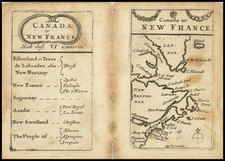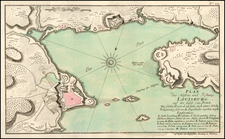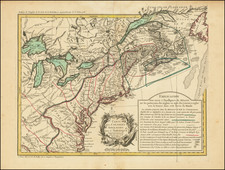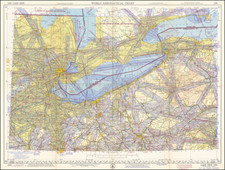Planning Railroads and Canals in Nova Scotia
Fine large set of 4 hand drawn maps, setting for the routes of the Subenacadie Canal and Nova Scotia Railway.
The set of four maps would appear to be a set of drawings created during the planning and surveying of the routes of both Subenacadie Canal and Nova Scotia Railway during the mid-1850s. The maps include pencil notes and calculations which suggest that the map was used during the planning stages of one of the projects, although curiously, more likely the Nova Scotia Railway, as the locks for the canals seems to have been finished or nearly so and do seem to have any pencil notes associated with the technical details of the route.
The series of 4 sheets illustrates the area between Halifax Harbor on Map No. 1 to Bay Verte on Map No. 4, passing through Truro on Map No.3. The map focuses on the routes of the Subenacadie Canal and Nova Scotia Railway, but also includes the major roads in the region (in Yellow) and what appears to be the route of the canal in red and the railway in black.
At the bottom of each of the sheets, there are profile views showing elevations, which track relevant sections of the Railway. Map No. 1 and Map no. 2 also include profile views for the canal and locks.
A number of bridges are shown across the various rivers, with additional notes in pencil identifying land owners, mills and a school house, as well as a reference to Joseph Witherbys, likely Joseph Weatherby (1798-1871).
While the map is unsigned, it may be the work of Sandford Fleming or Peter Crerar.
Shubenacadie Canal
The Shubenacadie Canal inks Halifax Harbour with the Bay of Fundy via the Shubenacadie River and Shubenacadie Grand Lake. The Canal was commenced in 1826, but remained unfinished until 1861. Its useful life was brief, as it was closed in 1871.
The canal was originally surveyed by William Owen in 1767, although no formal proposal was made to build the canal until the end of the 18th Century, when the government of Nova Scotia commissioned Owen to follow the Shubenacadie waterway from the Atlantic Ocean to Cobequid Bay. The Shubenacadie Canal Company began work in 1826, but the company failed by 1831. Work would not begin again until 1854, when the project was revived by the Inland Navigation Company. Steam boats and barge traffic began in 1856 and the canal completed in 1861.
While the canal enjoyed a few good years during the Waverley gold rushes of the 1860s. It proved unsustainable because of problems and experienced issues relating to frigid winters which damaged the locks.
The canal's ongoing construction delays were partly responsible for the 1851 decision by Nova Scotia's colonial government to build the Nova Scotia Railway, which built lines from Halifax to Windsor and Truro by 1858. Railway construction created a short-term surge in canal traffic but a decision in 1870 by the Intercolonial Railway to replace the Waverley draw bridge over the canal with a fixed bridge blocked canal steamships and severely limited canal traffic, a conflict related to the frog wars which plagued rival railways crossings. A final blow was a takeover by the Town of Dartmouth of the Dartmouth Lakes for the city's water supply which ended canal operations in 1871.
Nova Scotia Railway
The Nova Scotia Railway (NSR) was composed of two lines, one connecting Richmond (immediately north of Halifax) with Windsor, the other connecting Richmond with Pictou Landing via Truro.
The NSR was formed in March 1853, with a charter to build railway lines from Halifax to Pictou by way of Truro, as well as from Halifax to Victoria Beach, Nova Scotia on the Annapolis Basin and a charter to build from Truro to the border with New Brunswick.
The Windsor Branch was opened in June 1858 and the line to Truro (Eastern Line) was opened in December 1858. The line to Victoria Beach did not continue beyond Windsor. The Eastern Line to Pictou Landing was completed in June 1867.
Construction of the Nova Scotia Railway by the colonial government was partly encouraged by the construction failures and ongoing delays in building the Shubenacadie Canal .The success of the railway came at the expense of the canal which opened in 1861, but soon fell into disrepair from lack of use (and because the rail bridges over the canal were too low for the steamers on the canal).
The Government of Canada dissolved the NSR in 1872 when it became part of the Intercolonial Railway.












![[Gulf of St. Lawrence, Isle de Anticosti, District De Gaspe] Amer. Sep. No. 36 Partie Du Bas Canada](https://storage.googleapis.com/raremaps/img/small/96406.jpg)

![[ French & Indian War Battle Plan--Louisbourg ]. Plan De Louisbourg...](https://storage.googleapis.com/raremaps/img/small/57192.jpg)